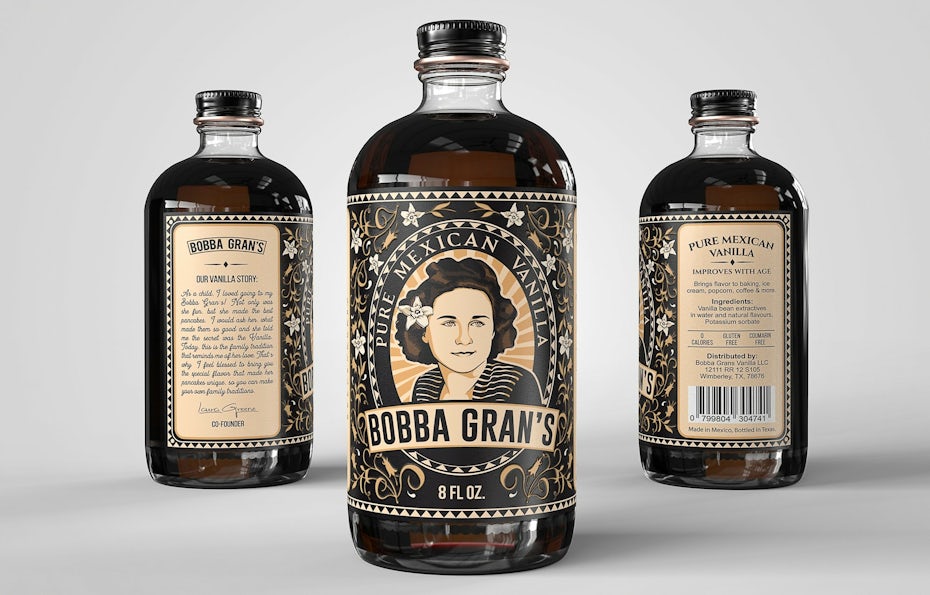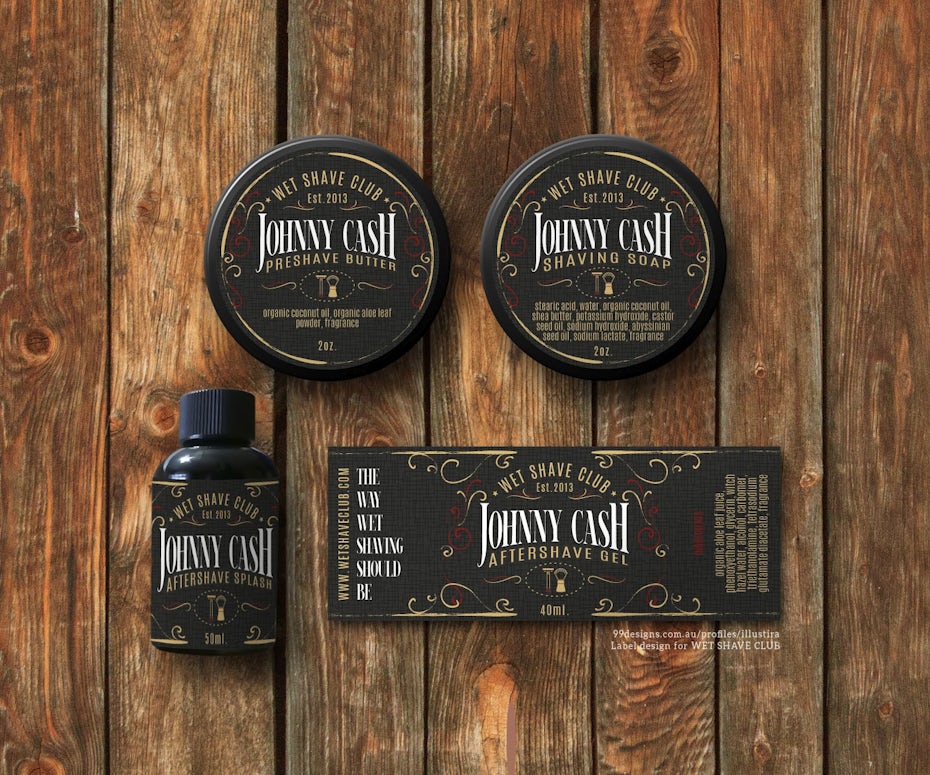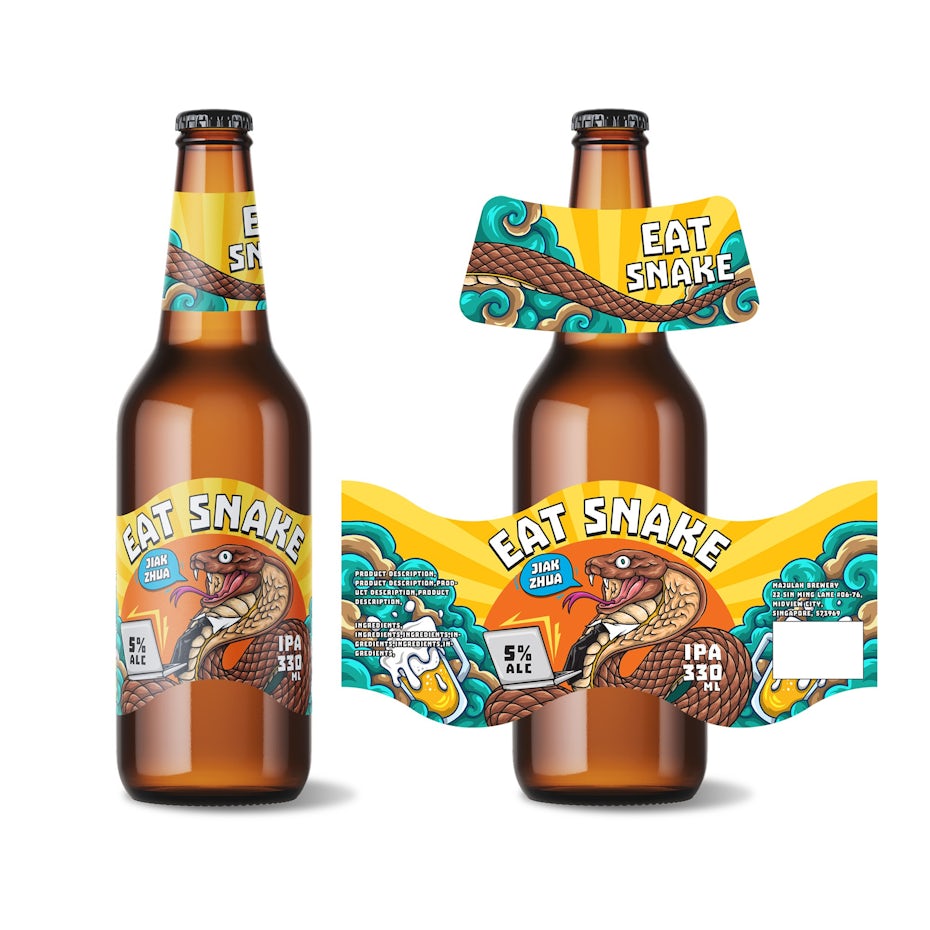A great label design is not only a practical business necessity, it can be an excellent space for creative ingenuity. Whereas logos often must be small and versatile, product labels provide a much larger canvas. But creative label design must serve a purpose: informing the prospective buyer about their purchase. They do so both directly with copy that identifies and describes the product and indirectly with color and artwork that convey the overall experience. All in all, to design a label is to create an expectation, which is why it is so important to send the right message.

Designing a label can seem like a complicated undertaking at first. Labels must accomplish the task of standing out and evoking the product’s unique qualities all while fitting within the company’s established brand. There are also technical considerations: what information to include and where, the shape of the container, and the limitations imposed by printing expenses. To simplify all of this, we’re going to walk you through every step in this complete guide to label design.
The product label checklist
Before you can create or commission a label design, there are a few things that the client will need to have ready for the designer ahead of time. This will make the design process go much smoother, ensuring that you avoid any rushed, last-minute design changes due to a lack of planning.
Packaging dimensions
The container, of course, comes before the label. Begin by researching packaging suppliers or manufacturers (a quick Google search can help you find one in your area), and choose a container. Be sure to take note of the material, size/shape and pricing for bulk orders.
There are common label sizes associated with most standard packaging types, such as a 12oz beer can or a 750ml wine bottle. Usually, as long as you know the packaging dimensions, the designer can creatively determine the appropriate label dimensions that will fit.
Printing service
The printing service will take the final design file and create your finished label. All the same, it is good foreplanning to find out the printer’s technical requirements and pricing before seeing a designer—e.g. file formats, sizing restrictions, costs for additional colors, or fancy extras like foiling, finishes and mattes. Some printing services (like Vistaprint) provide readymade blank label templates based on your dimensions.
Selecting a printer in tandem with your packaging manufacturer will help you make sure the label size and adhesive will work with your packaging shape and material. Some packaging suppliers may double as a printing service or have printers they recommend (or vice versa).
Logo and branding
A label design is no substitute for a logo, and it is a common rookie mistake to commission a label design before giving any thought to your company brand. A logo represents the overall business’s identity through a simplified symbol whereas the label acts more or less as a signpost for a particular product.
A label design ultimately fits within the umbrella of brand identity, and for that reason, it is important to have your logo and brand created beforehand. This includes considerations like brand colors and fonts, all of which the label designer will use to keep their work visually consistent with the rest of your identity.

Product description
The description gives practical information about the product—usually in paragraph form—that the consumer can read at their leisure. The details included here will depend on your product. For example, something medicinal like a supplement may include directions, steps and warnings. Alcoholic beverages, on the other hand, will include an ABV percentage along with volumetric measurements. All of this is why it is ideal to have a copywriter draft this up ahead of time so that the designer will know exactly how much space to set aside.
Nutritional facts or ingredients
Nutritional facts will display the ingredients and their quantities in table form, particularly for consumable products. It is most important at this stage to know how many ingredients you are working with as this will dictate how big the table should be.
Barcode
Barcodes are administered by the global nonprofit GS1, and you can purchase one through their website. If you decide to purchase a barcode after the label design process, the designer should leave space for it and provide a walkthrough on how to add it to the file later on.
Creative brief
The creative brief is a single document that describes your project and includes your technical requirements and aesthetic preferences. Its purpose is to guide the project throughout the design process. Essentially, this is where you will collect all of the above information and hand it over to a label designer. In addition, a creative brief should include targeted audience and competitor research as well as examples of label designs that fit the style you are going for.
Common types of product labels
Labels come in a number of common variations or parts. Accounting for all of these parts before speaking to a designer will help ensure accurate pricing for labor at the start of the project.
Some of these label types will depend on the shape of the container. Even container types that consist of a single wrap-around label (a can, for example) will make use of separate content areas that mimic separate labels. To get a better idea of how this works, we’ll go over some common examples.
Front label
When people think of label design, this is typically what they picture. It is the foremost label, meant to identify the product and stand out on a shelf (or on a shopping app) through creative visuals.

It usually consists of a product name, flavor variety name, logo, tagline, decorative imagery, and supporting information (such as container size, packing date, or location where the product was made). Because this part of the label is meant to generate immediate interest, the amount of writing is generally kept to a minimum and well-designed visuals take precedence.
Back label
The back label contains the extended product description, ingredients, barcode, certification icons, and any other necessary fine print. Some of this content may be displayed on either side of the container in addition to the back (in the case of a wrap-around label, for example).

Because the consumer is presumably interested in the product at this point (enough to pick it up and turn it over), the purpose of the back label is to convey straightforward information as clearly as possible. Visually, it should remain consistent with the front label, but the written text will take precedence.
Lid label
A small container such as a short tin may have a label on the top of the lid. This will function essentially the same as the front label. Depending on the size of the container, the lid might provide more space for graphic elements than the front.

Quality seal
Some jars will include a seal over the lid, the purpose of which is to warn customers not to purchase the product if the seal has been broken. While entirely functional, they can also be a space for branded typography and decorative patterns.
Neck label
A bottle may come with a label on the upper neck. This can be a miniature, minimized version of the front label, where the product logo and graphic elements are reinforced.


